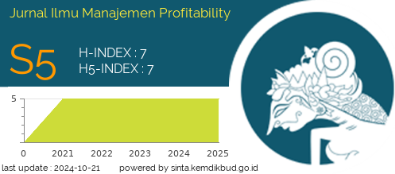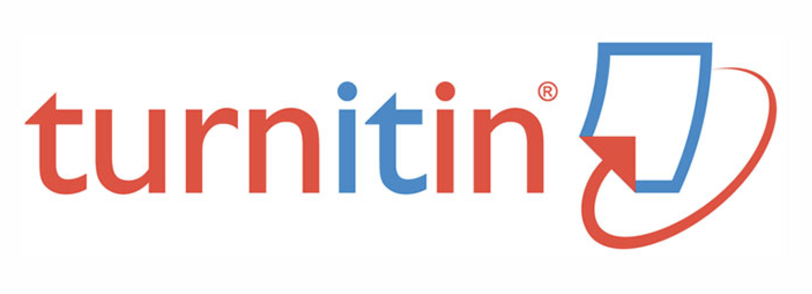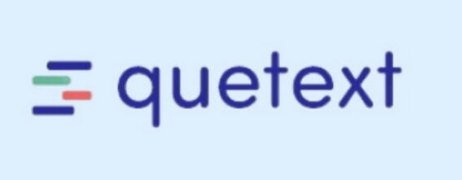Analysis of Commercial and Fiscal Profits, Leverage on Profit Persistence at PT. Mighty True Great
DOI: https://doi.org/10.26618/profitability.v8i2.13922
Difference in commercial and fiscal profit, persistence of profit, permanent difference, temporary difference, leverage.
Abstract
This study, titled "Analysis of Commercial and Fiscal Profits, Leverage on Profit Persistence at PT. Mighty True Great," aims to investigate the impact of differences in commercial and fiscal profits, leverage, and their combined effects on profit persistence at PT. Mighty True Great. The research employs quantitative methods and utilizes financial statements from 2017 to 2019 for data analysis. Financial statements serve as a crucial tool for conveying a company's financial status to various stakeholders. Profit quality, particularly profit persistence, is an essential component in assessing a company's performance and making informed decisions. The study focuses on the phenomenon of differences between accounting profits and fiscal profits, known as Book-Tax Differences, and how these differences influence profit persistence. The research explores the role of leverage in shaping financial statements and its potential impact on profit persistence. Leverage, represented by the Debt to Equity Ratio, is highlighted as a significant factor affecting profit persistence. The study specifically investigates PT. Mighty True Great, a company operating in the animal feed industry, and analyzes its profit trends and the influence of leverage on profit persistence. The findings reveal that differences in commercial and fiscal profits, both temporary and permanent, have no significant impact on profit persistence at PT. Mighty True Great. However, the study identifies that leverage has a notable influence on profit persistence, suggesting that the company's debt levels affect its ability to sustain profits over time. In conclusion, the research emphasizes the importance of companies paying attention to profit stability and persistence. For future studies, researchers are encouraged to explore additional variables that may impact profit persistence and extend the observation period to provide a more comprehensive understanding. The recommendations aim to guide companies in decision-making and offer valuable insights for potential investors considering the persistence of a company's profits.References
Achyarsyah, P., &; Purwanti, A. J. (2018). Effects Of Differences In Commercial Profit And Fiscal Profit, Deferred Tax, And Leverage On Profit Persistence. Journal Of Accounting Science, 16(2), 56.
Agustian, S. (2020). The Effect Of Managerial Ownership, Company Size, Leverage, Audit Fees, Cash Flow, Market Concentration, Debt Levels, And Box Tax Difference On Profit Persistence (Case Study On Property And Real Estate Companies Listed On The Indonesia Stock Exchange. Research Platformaccounting Students, 138–47. Https://Ojs.Stiesa.Ac.Id/Index.Php/Prisma
Camille, E., &; Effriyanti. (2020). The Effect Of Book Tax Differences And Volatility Flows. 2(1), 28–44.
Diharjo, J. P., &; Leon, M. (2020). The Effect Of Book Tax Differences And Debt Level On Profit Persistence (Empirical Study On Property And Real Estate Sector Companies Listed On The Indonesia Stock Exchange In 2016-2018) Dap Persi. Krisnadwipayana Journal Of Accounting And Business, 7(3), 46–62.
Fanani, Z. (2010). Analysis Of The Determinants Of Profit Persistence. Indonesian Journal Of Accounting And Finance, 7(1), 109–123. Https://Doi.Org/10.21002/Jaki.2010.06
Gunarto, R. I. (2019). The Effect Of Book Tax Differences And Debt Levels On Profit Persistence. Indonesian Journal Of Sustainable Accounting, 2(3), 328–344.
Hardi, M. A. H., & Purwanti, S. N. (2014). The Effect Of The Difference Between Accounting Profit And Fiscal Profit On Profit Retention (Mudrika Alamsyah Hasan, Hardi &; Sheila Nika Purwanti). Journal Of Accounting, 2, 149–162.
Heri Prasetyo, B., &; Rafitaningsih, R. (2015). Analysis Of Book Tax Differences On Profit Persistence, Accruals And Cash Flow In Telecommunication Service Companies. Jiafe (Scientific Journal Of Accounting, Faculty Of Economics), 1(1), 27–32. Https://Doi.Org/10.34204/Jiafe.V1i1.293
Imanda Shefira, B., Wibowo Agung S, R. E., & . A. (2019). The Effect Of Book-Tax Differences, Company Size And Profit Before Tax For The Current Year On Profit Persistence In Manufacturing Companies Listed On The Indonesia Stock Exchange In 2011-2015. Maximum, 8(2), 95. Https://Doi.Org/10.26714/Mki.8.2.2018.95-108
Cashmere. (2018). Financial Statement Analysis. Pt. King Grafindo Persada. Kepramareni, P., Pradnyawati, S. O., &; Swandewi, N. N. A. (2021). Profit Quality
And Influential Factors (Case Studies On Manufacturing Companies In 2017-2019). Economic Discourse (Journal Of Economics, Business And Accounting), 20(2), 170–178. Https://Doi.Org/10.22225/We.20.2.2021.170-178
Kusuma, I. Gede, Supriyadi, &; Prasetyo, K. (2019). Income Tax Practicum (Corporate Income Tax) (B. Setiawan (Ed.); Ed. I). Andi.Https://Www.G Oogle.Co.Id/Books/Edition/Praktikum_Pajak_Penghasilan_Pph_Badan/Z_Z1dwaaqbaj?Hl=En&Gbpv=1
Maleong, J. M. N., Tangkau, J., &; Kawulur, H. (2021). The Effect Of Book Tax Differences And Debt Levels On Profit Intensity In Manufacturing Companies Listed On The Indonesia Stock Exchange 2016-2019. Manado Journal Of Accounting (Jaim), 2(1), 51–63. Https://Doi.Org/10.53682/Jaim.V2i1.866
Maulana, J., &; Triana, G. G. M. (2021). The Effect Of "Debt To Asset Ratio On Profit Persistence In The Basic Industrial And Chemical Sectors Listed On The Indonesia Stock Exchange" In 2016-2019. Land Journal, 2(2), 80–94. Https://Doi.Org/10.47491/Landjournal.V2i2.1348
Ng Eng, J., &; Wahyuni, E. T. (2013). Practical Guide To Financial Accounting Standards 2nd Edition. Salemba Four.
Nuraeni, R., Mulyati, S., &; Putri, T. E. (2019). Factors Affecting Profit Persistence (Case Study On Property And Real Estate Company Listed On Indonesia Stock Exchange In 2013-2015). Accruals, 2(1), 82–112. Https://Doi.Org/10.35310/Accruals.V2i1.8
Olivia, E., &; Viriany. (2021). The Effect Of Operating Cash Flow And Company Size On Profit Persistence. At-Tadbir : Scientific Journal Of Management, 5(2), 120. Https://Doi.Org/10.31602/Atd.V5i2.4549
Persada, A. E., &; Martani, D. (2010). Analysis Of Factors Affecting The Book Tax Gap And Their Effect On Profit Persistence. Journal Of Accounting And Finance Indonesia, 7(2),205–221. Https://Doi.Org/10.21002/Jaki.2010.12
Prananditya, A., Andini, R., &; Andika, A. (2021). The Effect Of Sales Growth And Leverage On Profit Management In ... - Google Books (M. Syairozi (Ed.)). Indonesian Science Media. Https://Www.G Oogle.Co.Id/Books/Edition/Pengaruh_Pertumbuhan_Penjualan_
Putri, S. A., A, K., &; M, K. (2017). Operating Cash Flow, Book Tax Differences, And Levels Of Debt To Profit Persistence. Journal Of Contemporary Accounting Research, 9(1), 29–38. Https://Doi.Org/10.23969/Jrak.V9i1.365
Rahmawati, R. N. (2019). The Effect Of Book Tax Differences, Operating Cash Flow, And Debt Levels On Profit Persistence.
Rahmayani, M. W. (2020). Jaksi Journal Of Financial Accounting And Information Systems. Journal Of Financial Accounting And Information Systems, 1, 12–27.
Official, S. (2009). Taxation: Theories And Cases (5 Ed.). Salemba Four.
Rianto, &; Murtiani, D. N. (2019). The Effect Of Book Tax Differences On Profit Quality In Consumer Goods Sector Companies In Indonesia. Akrual Journal Of Accounting And Finance, 1(1), 65–83. Https://Uia.E- Journal.Id/Akrual/Article/View/1015
Schipper, K., & Vincent, L. (2003). Earnings Quality. Accounting Horizons, 17(Suppl.), 97–110. Https://Doi.Org/10.2308/Acch.2003.17.S-1.97
Septavita, N. (2016). The Effect Of Book Tax Differences, Operating Cash Flow, Debt Levels, And Company Size On Profit Persistence. Science Of Surverying And Mapping, 41(2007), 1309–1323.
Setijaningsih, T. And, &; Veronika. (2022). The Effect Of Accrual, Leverage, And Operating Cash Flow On Profit Persistence With Book Tax Difference S As A Moderation Variable. 139–158.
Soa, B., Tamansiswa, U. S., Ayem, S., & Tamansiswa, U. S. (2021).Influence Allocation Tax Escort Era ,Leverage.4(November), 287–292.
Sugiyono. (2017). Quantitative, Qualitative, R&D Research Methods. Cv. Alfabeta.
Sugiyono. (2019). Quantitative, Qualitative, R&D Research Methods. Cv. Alfabeta.
Suhayati, Abbas, D. S., &; Hakim, M. Z. (2021). The Effect Of Book Tax Differences, Operating Cash Flow, Debt Levels, Sales Volatility And Institutional Ownership On Profit Persistence. Penman 2001, 514–526. Https://Doi.Org/10.32528/Psneb.V0i0.5204
Suteja, I. G. N. (2018). Financial Performance Analysis Using Altman Z-Score Method At Pt Ace Hardware Indonesia Tbk. Monetary, V(1), 12–17. P-Issn 2355- 2700 E-Issn 2550-0139
Sutisna, H., &; Ekawati, E. (2016). Profit Persistence At The Company And Industry Level In Relation To Cash Flow Volatility And Accruals. Xix National Symposium On Accounting, Lampung, 1993, 1–19.
Trisnasari, A. T., Sujana, E., &; Herawati, N. T. (2017). The Influence Of Taxpayer Awareness, Tax Socialization And Tax Knowledge On Taxpayers' Willingness To Participate In The Tax Amnesty Program. E- Journal S1 Ak Ganesha University Of Education, 7(1).
Law No.36 Of 2008 Concerning Income Tax (Pph). (N.D.).
Downloads
Published
Issue
Section
License
Authors who publish with Jurnal Ilmu Manajemen Profitability agree to the following terms:
Copyright of the articles remains with the authors.
Authors grant the journal the right of first publication with the work simultaneously licensed under a Creative Commons Attribution-NonCommercial 4.0 International License (CC BY-NC 4.0). This license allows others to:
Share (copy and redistribute the material in any medium or format)
Adapt (remix, transform, and build upon the material)
as long as they give appropriate credit to the original author(s) and source, provide a link to the license, and indicate if changes were made. Non-commercial use only.
Authors are permitted to:
Distribute their published work (e.g., post it to an institutional repository or publish it in a book), with an acknowledgment of its initial publication in this journal.
Enter into separate, additional contractual arrangements for the non-exclusive distribution of the journal’s published version of the work (e.g., post it to a class website or institutional archive).
For permissions to use the content published in this journal beyond the scope of the license (e.g., commercial purposes), please contact the editorial office via the journal email.
License Details:
This journal is licensed under a Creative Commons Attribution-NonCommercial 4.0 International License (CC BY-NC 4.0).












